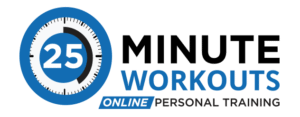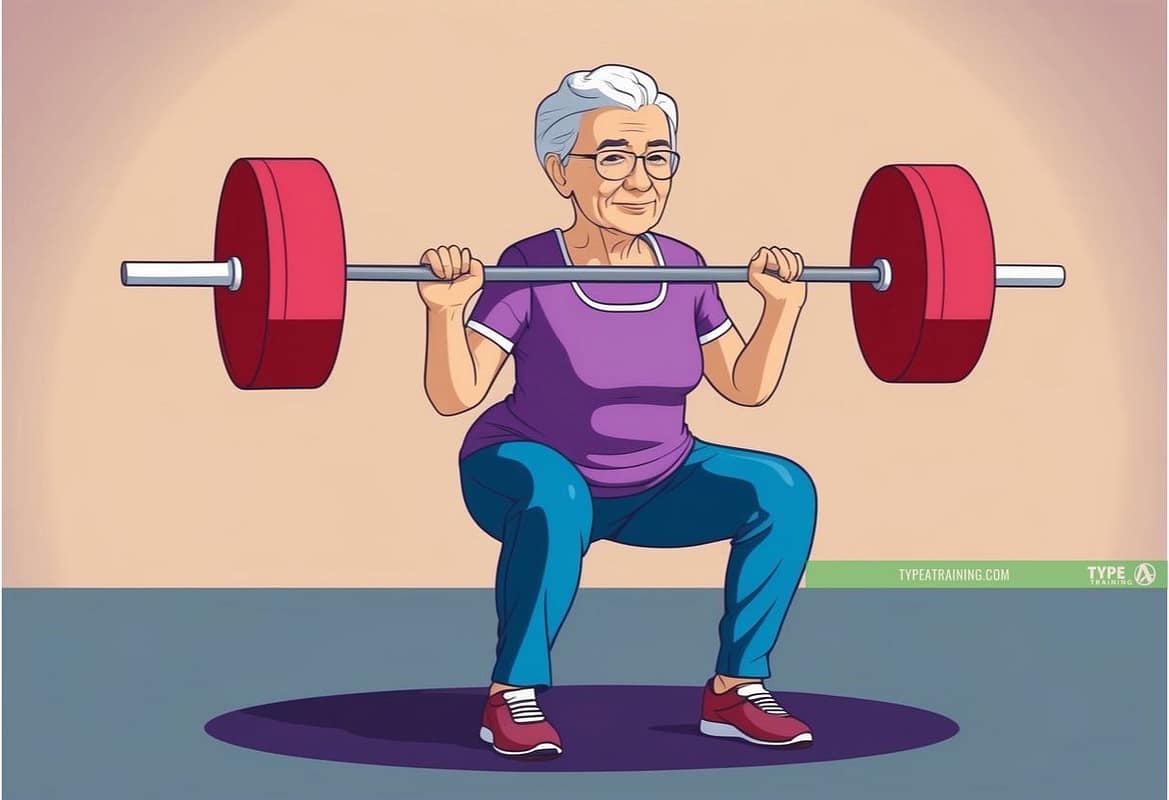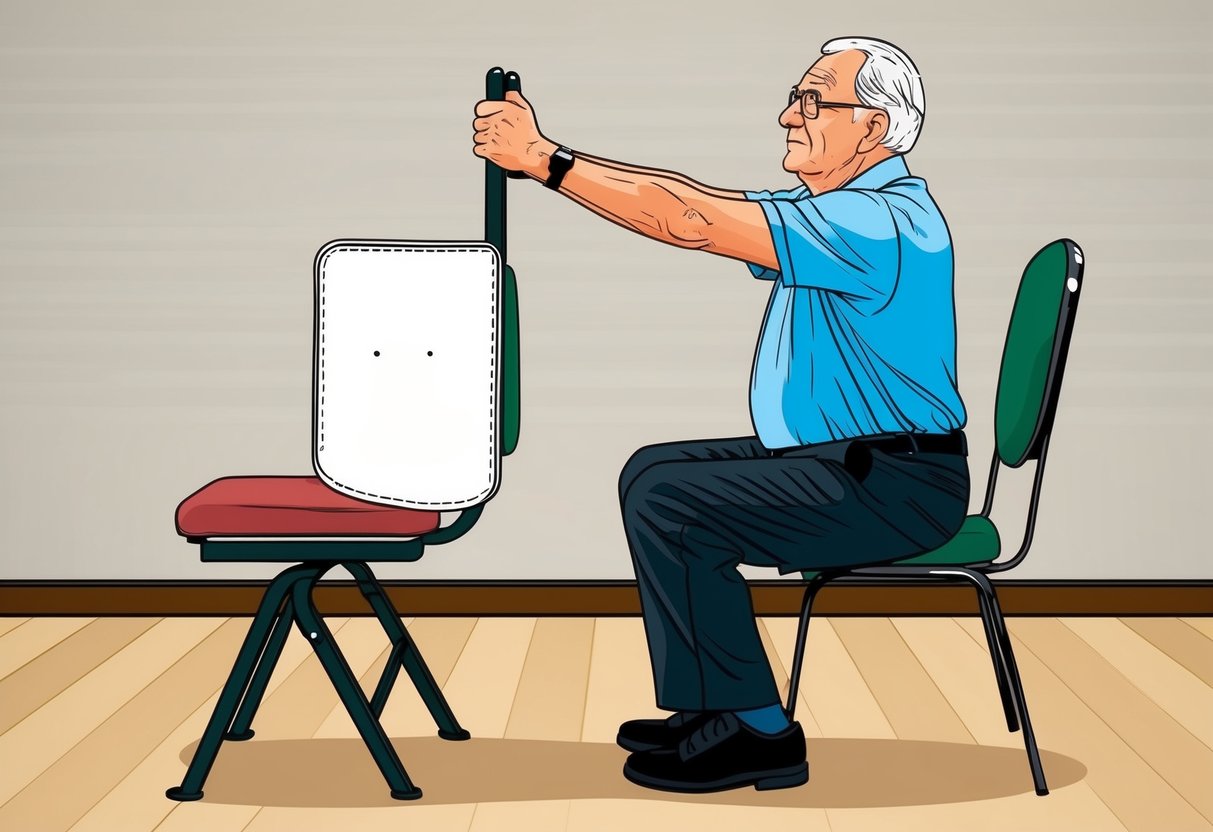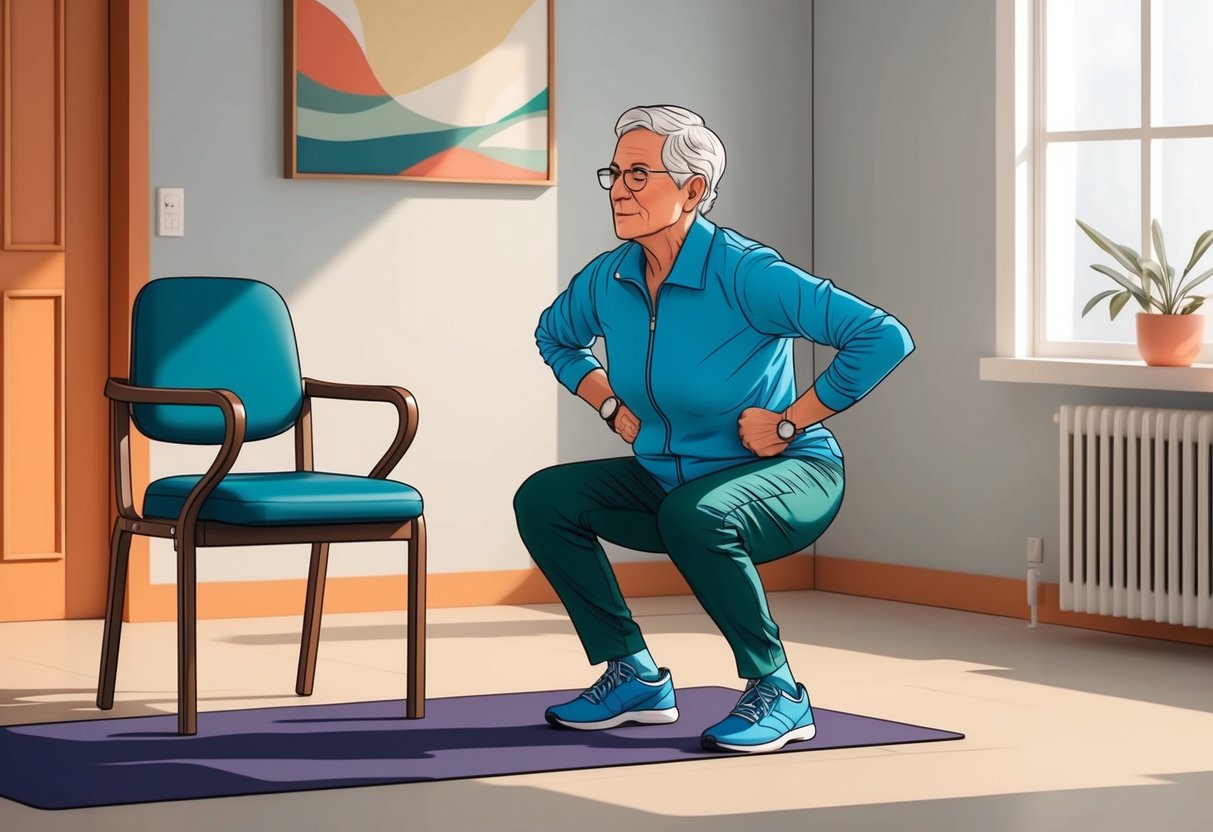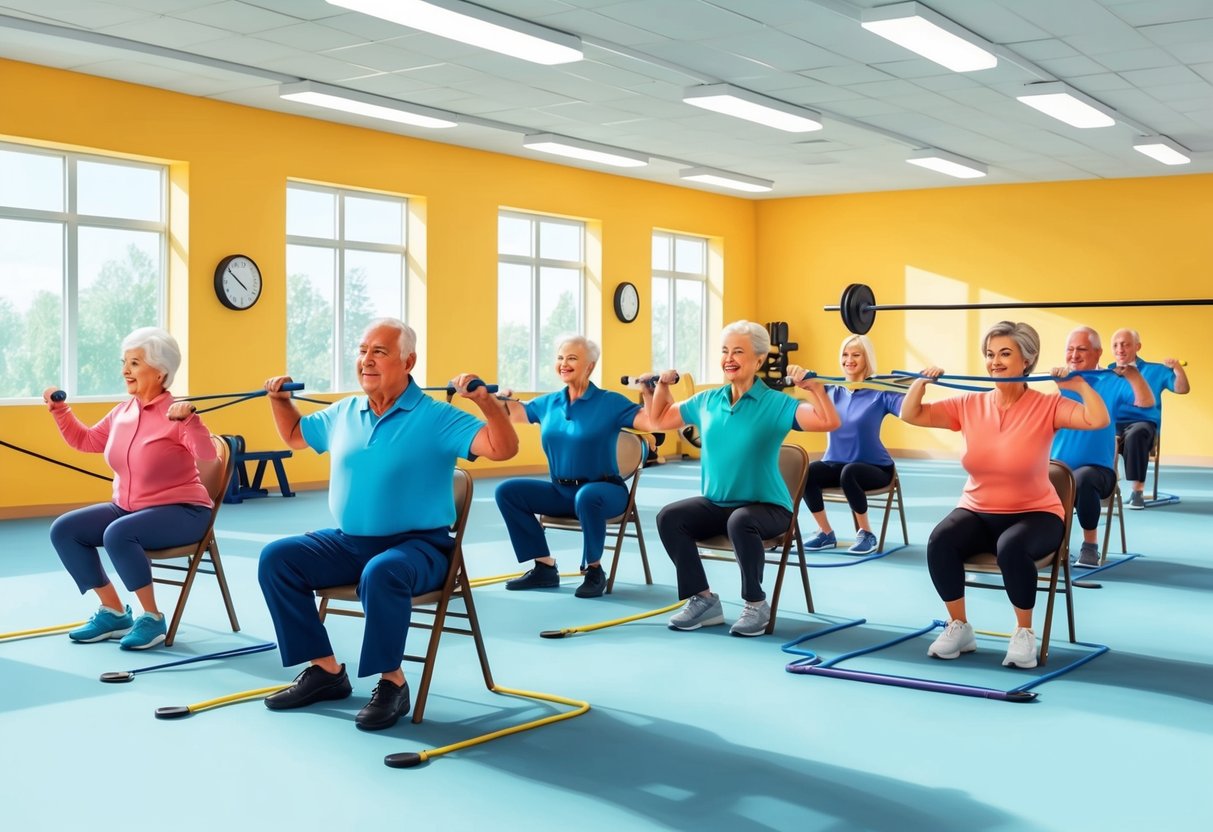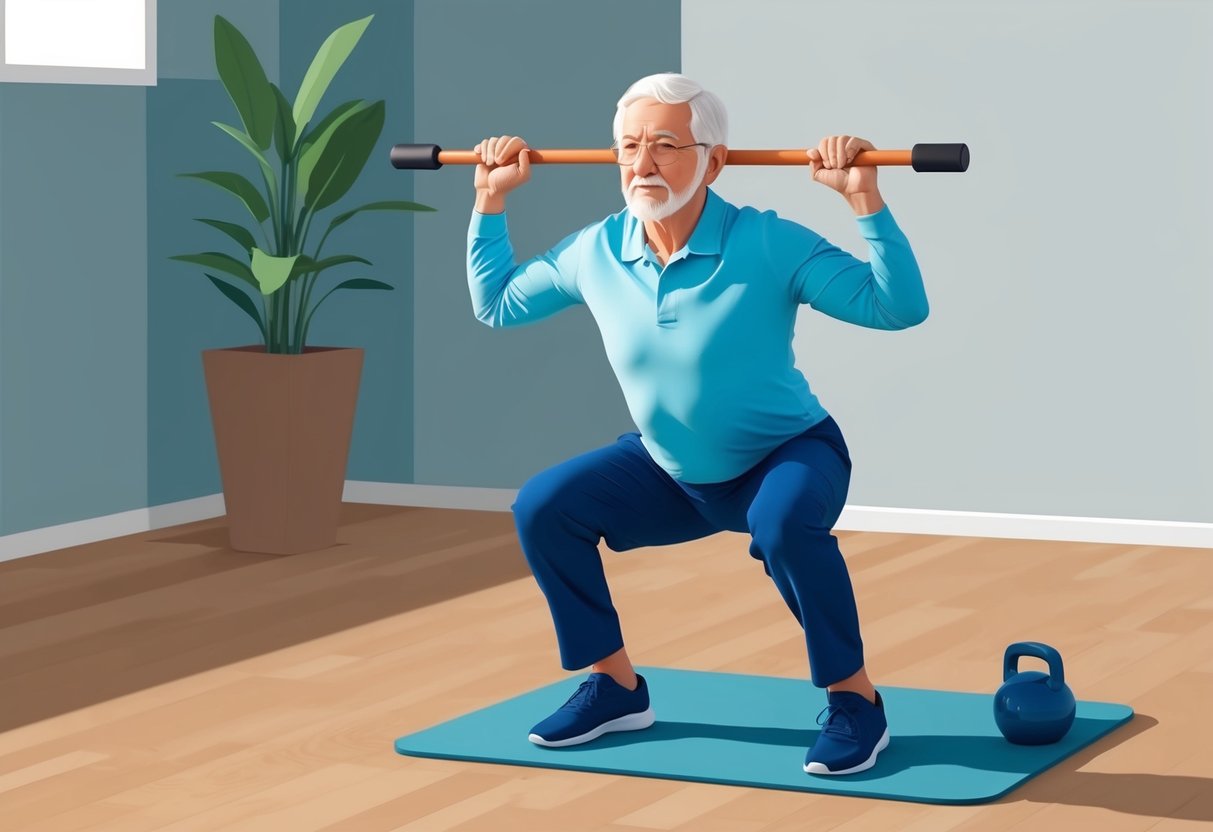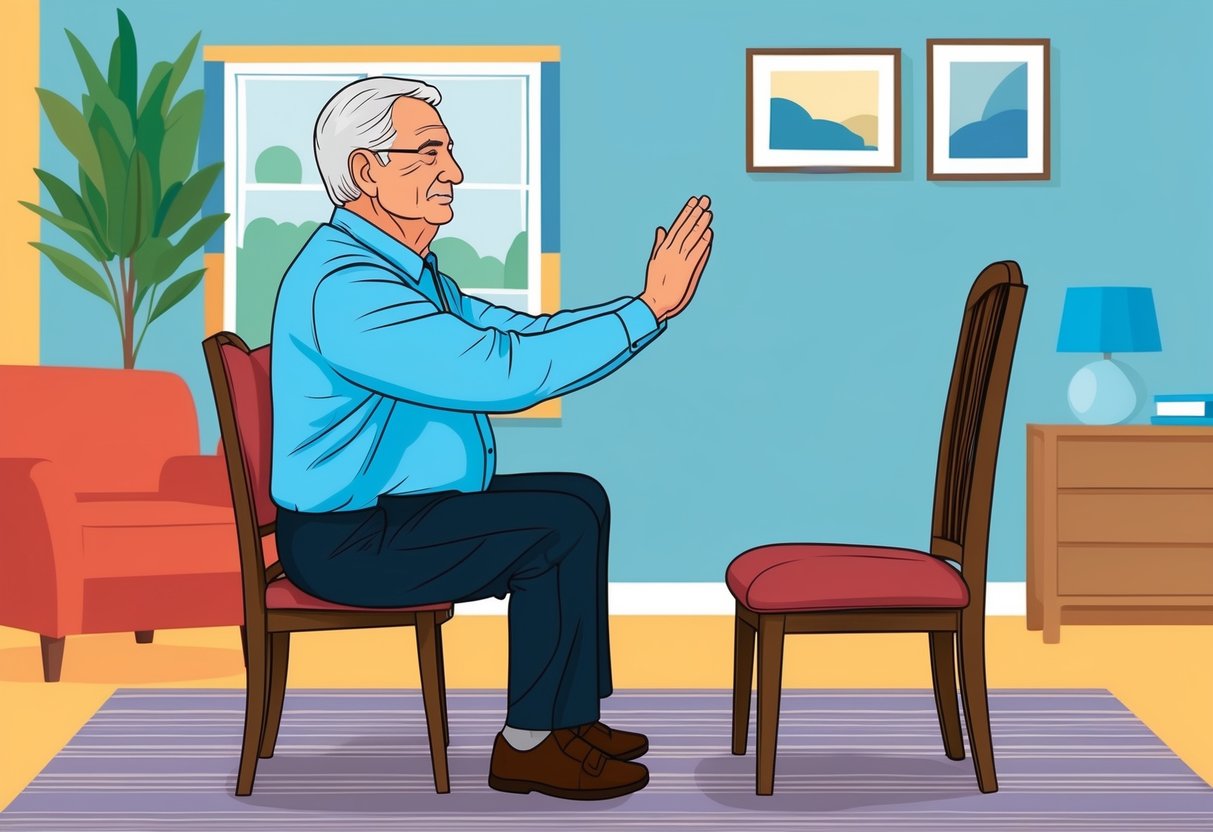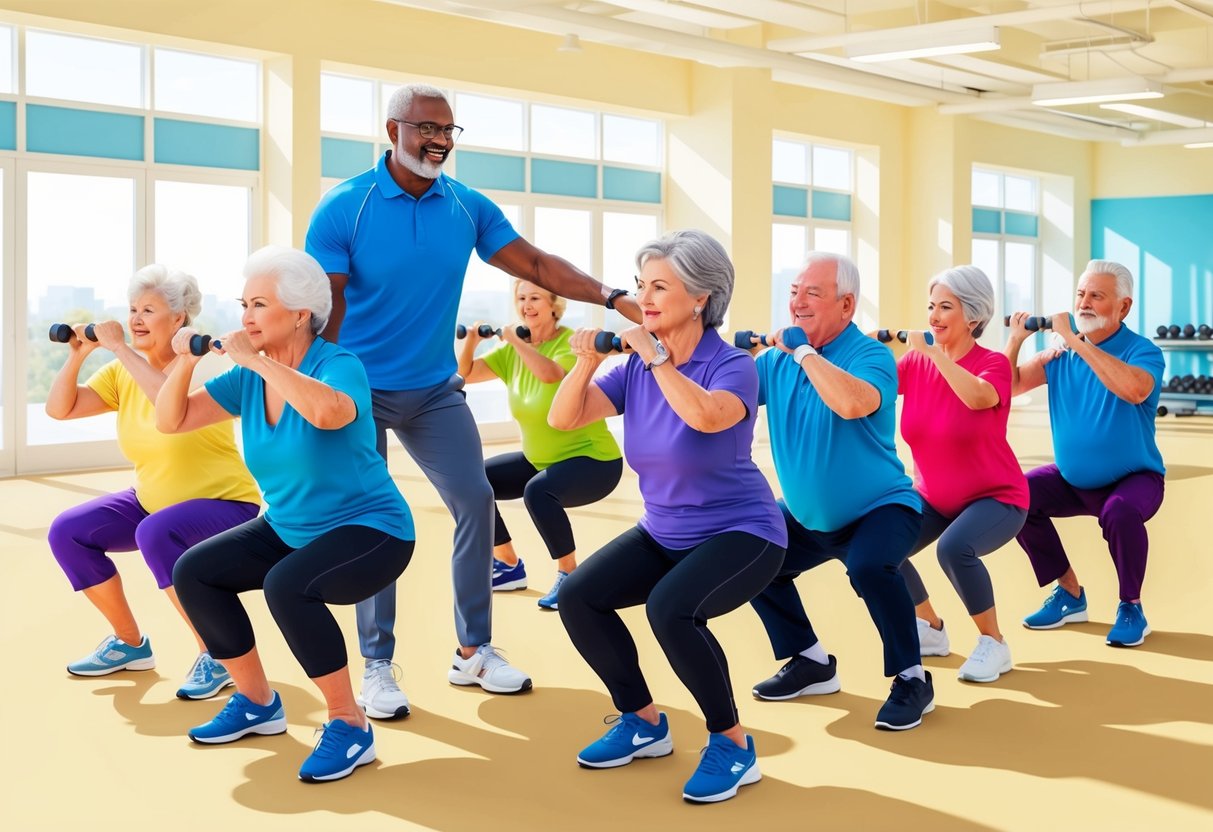Squats are a fundamental exercise that can greatly benefit seniors. As we age, maintaining strength and mobility becomes increasingly important for our overall health and independence.
Incorporating squat exercises into your routine can improve balance, strengthen leg muscles, and enhance your ability to perform daily activities.

Squats are considered one of the most important exercises for older adults, as they mimic movements we use in everyday life, such as sitting down and standing up. By practicing squats regularly, you can reduce the risk of falls and maintain your functional fitness well into your golden years.
Don’t worry if you’re new to squats or have limited mobility.
Popular Posts
- Massage Gun vs. Foam Roller: Which Recovery Tool Reigns Supreme?
- 27 Best Calisthenics Exercises for Full-Body Strength and Fitness
- 10 HIIT Workouts for Busy Professionals: Max Fitness, Min Time
- Good Posture Working from Home: Optimize Your Workspace to Prevent Discomfort and Health Issues
- The Best Crossfit Exercises for Full-Body Conditioning
There are many variations of squats that can be adapted to different fitness levels and physical limitations. With proper technique and guidance, you can safely incorporate this powerful exercise into your fitness routine and enjoy its numerous benefits.
Key Takeaways
- Squats improve balance, leg strength, and functional fitness for seniors
- Regular squat practice can enhance independence and reduce fall risk
- Various squat modifications exist to accommodate different fitness levels
Understanding Squats and Their Importance

Squats are a fundamental exercise that can greatly benefit seniors. They target multiple muscle groups, improve balance, and help maintain bone density.
By incorporating squats into your routine, you can enhance your overall strength and mobility.
Benefits of Squats for Seniors
Squats are a powerful exercise that can significantly improve your quality of life as you age. They enhance your lower body strength, making everyday activities like standing up from a chair or climbing stairs easier.
Squats also boost your balance and stability, reducing the risk of falls.
By performing squats regularly, you can increase your muscle mass, which tends to decline with age. This helps maintain your metabolism and supports weight management.
Squats also improve flexibility in your hips and ankles, promoting better overall mobility.
Additionally, squats can enhance your cardiovascular health by engaging large muscle groups and increasing blood flow throughout your body.
Muscle Groups Targeted by Squats
Squats are an excellent compound exercise that works multiple muscle groups simultaneously. The primary muscles targeted include:
- Quadriceps: Located on the front of your thighs
- Hamstrings: Found on the back of your thighs
- Glutes: Your buttocks muscles
- Calves: The muscles in the back of your lower legs
Squats also engage your core muscles, including your abdominals and lower back, to maintain stability throughout the movement.
This comprehensive muscle engagement makes squats one of the most important exercises for seniors.
Role of Squats in Maintaining Bone Density
As you age, maintaining bone density becomes crucial to prevent conditions like osteoporosis.
Squats play a vital role in this aspect of your health. When you perform squats, you create a beneficial stress on your bones, particularly in your legs, hips, and spine.
This stress stimulates bone formation and helps preserve bone mass.
Regular squat exercises can increase bone mineral density, making your bones stronger and more resistant to fractures.
The weight-bearing nature of squats also improves the strength of the connective tissues around your joints.
Squat Exercise Fundamentals
Squats are a cornerstone exercise for seniors, promoting strength, balance, and mobility. Mastering proper form, avoiding common mistakes, and building an effective routine are key to reaping the full benefits of this powerful movement.
Proper Squat Form and Technique
Start with your feet shoulder-width apart, toes pointing slightly outward. Keep your chest up and your gaze forward.
As you lower your body, imagine sitting back into a chair. Your knees should track over your toes, not extend past them.
Engage your core muscles and keep your back straight throughout the movement.
Lower yourself until your thighs are parallel to the ground, or as far as you comfortably can.
Push through your heels to return to the starting position.
Remember to breathe steadily – exhale as you rise, inhale as you lower. If balance is a concern, perform chair squats for added support.
Avoiding Common Squat Mistakes
One frequent error is allowing your knees to collapse inward. Focus on pushing your knees outward as you squat.
Avoid rounding your back or letting your chest drop forward, which can strain your spine.
Don’t rush the movement. Control your descent and ascent to maximize muscle engagement and reduce injury risk.
Refrain from bouncing at the bottom of the squat, as this can stress your joints.
If you experience knee pain, check that you’re not letting your knees extend too far forward. Keep most of your weight in your heels, not your toes.
Start with a smaller range of motion and gradually increase as you build strength and flexibility.
Building a Squat Routine
Begin with 2-3 sets of 8-10 repetitions, 2-3 times per week.
As you grow stronger, increase the number of repetitions or sets. Incorporate squats into your daily routine for consistent progress.
Vary your squat exercises to target different muscle groups:
- Standard bodyweight squats
- Wall squats for endurance
- Single-leg squats for balance
Always warm up before squatting. March in place or do gentle leg swings to prepare your muscles.
Cool down with light stretches afterward to maintain flexibility.
Listen to your body and adjust the intensity as needed.
Consistency is more important than intensity, especially when starting out.
Gradually challenge yourself to deepen your squat or increase repetitions as you become more comfortable with the exercise.
Adapting Squats for Seniors
Squats can be modified to suit various fitness levels and physical limitations. By making adjustments, seniors can safely perform this beneficial exercise while addressing common concerns like knee and back pain.
Modifications for Knee and Back Pain
If you experience knee or back discomfort, try reducing the squat depth. Aim to lower yourself only as far as comfortable, even if it’s just a few inches. Chair squats can provide added support and stability.
For those with lower back issues, focus on maintaining a neutral spine throughout the movement. Engage your core muscles to protect your back.
You can also try placing a small cushion or rolled towel behind your lower back when performing wall squats.
If knee pain is a concern, experiment with foot placement. A slightly wider stance or turning your toes out slightly may alleviate pressure on your knees.
Safe Squat Variations for Seniors
Wall squats are an excellent option for beginners.
Stand with your back against a wall and slowly slide down, keeping your feet shoulder-width apart. Hold the position briefly before pushing back up.
Box squats involve sitting back onto a sturdy chair or bench. This variation helps you maintain proper form and provides a safety net if you lose balance.
Chair squats are another safe option. Start by sitting in a chair, then stand up without using your hands. Slowly lower yourself back down, just touching the seat before standing again.
Incorporating Support and Stability Aids
Using a sturdy chair or countertop for balance can increase your confidence and safety while performing squats. Place the support in front of you and lightly rest your hands on it.
Resistance bands can provide assistance and improve your form. Loop a band around a stable object at chest height and hold the ends while squatting.
For added stability, try using a balance ball between your lower back and a wall. This helps maintain proper alignment and provides feedback on your form.
Building Strength and Mobility with Squats
Squats offer seniors a powerful way to enhance overall physical function. This exercise targets multiple muscle groups while improving flexibility, balance, and coordination.
Enhancing Flexibility Through Squats
Squats can significantly increase your range of motion and flexibility. As you lower your body, your hip flexors, hamstrings, and ankles stretch, promoting better mobility.
To maximize flexibility benefits:
- Start with shallow squats and gradually increase depth
- Focus on proper form, keeping your chest up and back straight
- Hold the bottom position for a few seconds to deepen the stretch
Incorporate variations like sumo squats to target different muscle groups and joint angles.
Remember to breathe steadily throughout the movement.
Improving Balance and Coordination
Squats challenge your body’s stability systems, enhancing balance and coordination. These skills are crucial for preventing falls and maintaining independence.
To boost balance benefits:
- Practice bodyweight squats near a sturdy chair for support
- Progress to unassisted squats as you gain confidence
- Try single-leg squats to further challenge your balance
Focus on controlled movements and maintain proper alignment. Keep your core engaged throughout the exercise to improve overall stability.
Progressive Squat Challenges
As your strength and mobility improve, introduce progressive challenges to continue seeing benefits.
Start with basic bodyweight squats and gradually increase difficulty:
- Wall squats: Lean against a wall for support
- Chair squats: Use a chair to guide your movement
- Bodyweight squats: Perform squats without support
- Weighted squats: Add light dumbbells or resistance bands
Adjust the number of repetitions and sets based on your fitness level.
Aim for 2-3 sets of 8-12 repetitions, increasing as you get stronger.
Always listen to your body and consult a healthcare professional before starting a new exercise routine.
Best Squat Variations for Seniors
Squat exercises can be adapted to suit various fitness levels and physical capabilities of older adults. These variations focus on safety, stability, and effectiveness while targeting key muscle groups.
Chair Squats
Chair squats provide a secure and stable way for seniors to perform squats. This exercise strengthens leg muscles and improves balance.
To perform chair squats:
- Stand in front of a sturdy chair with feet shoulder-width apart.
- Slowly lower your body as if sitting down, keeping your back straight.
- Lightly touch the chair seat with your buttocks, then push through your heels to stand up.
- Repeat 8-12 times for 2-3 sets.
Chair squats are an excellent starting point for seniors new to squatting exercises.
Wall Squats
Wall squats offer support and help maintain proper form throughout the movement. They target the quadriceps, hamstrings, and glutes.
How to do wall squats:
- Stand with your back against a wall, feet hip-width apart and about 2 feet from the wall.
- Slowly slide down the wall until your thighs are parallel to the ground.
- Hold this position for 10-30 seconds, then slide back up.
- Aim for 5-10 repetitions.
As you build strength, try to increase the hold time gradually.
Assisted Squats
Assisted squats use external support to make the exercise more manageable and safer for seniors with balance concerns.
To perform assisted squats:
- Stand behind a sturdy chair or countertop, holding onto it for support.
- Place your feet shoulder-width apart.
- Lower your body by bending your knees and hips, keeping your back straight.
- Push through your heels to return to the starting position.
- Complete 8-12 repetitions for 2-3 sets.
Using resistance bands or holding onto a stable object can provide additional support during this exercise.
Box Squats
Box squats offer a defined target for depth and provide a brief rest at the bottom of the movement. This variation is particularly helpful for seniors working on building confidence in their squatting ability.
How to perform box squats:
- Place a sturdy box or bench behind you, about knee-height.
- Stand with feet slightly wider than hip-width apart.
- Slowly lower yourself as if sitting down on the box.
- Lightly touch the box with your buttocks, then immediately stand back up.
- Perform 8-12 repetitions for 2-3 sets.
Ensure the box or bench is stable and at an appropriate height for your flexibility.
Assisted Single-Leg Squats
Assisted single-leg squats help improve balance and strengthen each leg individually. This exercise is more advanced and should only be attempted after mastering other variations.
To do assisted single-leg squats:
- Stand next to a wall or chair for support.
- Shift your weight onto one leg, lifting the other slightly off the ground.
- Slowly lower your body by bending the supporting knee.
- Lower as far as comfortable, then push back up to the starting position.
- Perform 5-8 repetitions on each leg for 2 sets.
Always use support and stop if you experience any pain or discomfort. Bodyweight squats like these can significantly improve leg strength and balance in seniors when performed regularly and with proper form.
Listening to Your Body During Squat Workouts
When performing squat exercises, it’s crucial to pay attention to how your body feels. Listening to your body helps prevent injuries and ensures a safe, effective workout.
Start your squat routine slowly and focus on proper form.
If you experience sharp pain in your knees, hips, or back, stop immediately. Some muscle fatigue is normal, but pain is not.
Pay attention to your breathing during squats.
If you find yourself holding your breath or struggling to breathe, take a break. Proper breathing helps maintain stability and provides oxygen to your muscles.
Monitor your balance carefully. If you feel unsteady, use a chair or wall for support.
Maintaining balance is key to preventing falls and getting the most out of your workout.
Watch for signs of overexertion such as dizziness, nausea, or excessive sweating. These indicate it’s time to rest and hydrate.
Integrating Squat Exercises into a Daily Routine
Start your day with a simple squat routine to boost your fitness and mobility.
Chair squats are an excellent option for beginners.
Stand in front of a chair, lower yourself as if to sit, but don’t fully touch the seat. Aim for 5-10 repetitions twice daily.
As you gain strength, incorporate wall squats into your routine.
Lean against a wall and slide down until your thighs are parallel to the floor. Hold for 10-30 seconds, gradually increasing duration as you improve.
Try different squat variations to keep your workout interesting:
- Wide squats for inner thigh strength
- Narrow squats for balance improvement
- Seated squats for a gentler option
Aim to perform squats at least 3-4 times a week.
You can easily integrate them into your daily activities. For example, do a few squats while waiting for your coffee to brew or during TV commercial breaks.
Remember to listen to your body and progress at your own pace.
If you experience any pain or discomfort, consult with a healthcare professional or a certified fitness instructor to ensure proper form and technique.
Frequently Asked Questions
Squat exercises offer numerous benefits for seniors, but proper technique and adaptations are crucial. Safety, progression, and individual capabilities should be considered when incorporating squats into a senior fitness routine.
What are appropriate squat variations for seniors with knee issues?
For seniors with knee issues, chair squats can be an excellent alternative.
You can perform these by sitting down and standing up from a chair, using the chair for support if needed.
Wall slides are another option. Stand with your back against a wall and slowly slide down, bending your knees only as far as comfortable.
How can seniors incorporate weights into their squat exercises?
You can start by holding light dumbbells at your sides while performing regular squats.
As you gain strength, gradually increase the weight.
Another option is to use a weighted vest, which distributes weight evenly across your upper body.
Begin with a light weight and progress slowly.
What is the recommended number of squats for seniors to perform daily?
The ideal number of squats varies based on your fitness level and health condition.
Start with 5-10 squats per day and gradually increase.
Aim for 2-3 sets of 10-15 squats, 2-3 times a week. Regular squat exercises can be done at home with minimal equipment.
Can seniors perform barbell squats safely, and if so, how?
Barbell squats can be safe for seniors with proper technique and guidance.
Start with a lightweight bar or PVC pipe to practice form.
Always use a squat rack for safety.
Begin with a quarter squat, gradually increasing depth as you become comfortable.
Consider working with a fitness professional to ensure proper form.
What guidelines should seniors follow when doing squats at home?
Ensure you have a sturdy chair or countertop nearby for support.
Wear comfortable, non-slip shoes and exercise on a non-slippery surface.
Start with bodyweight squats and focus on proper form.
Keep your chest up, back straight, and knees aligned with your toes. Proper form and gradual progression ensure safe and effective squat workouts.
Are chair squats beneficial for seniors, and what is the proper technique?
Chair squats are highly beneficial for seniors. They improve leg strength, mobility, and balance.
To perform chair squats, stand in front of a chair with feet shoulder-width apart. Slowly lower yourself as if sitting down, but just before touching the chair, stand back up. Use the chair for support if needed.
